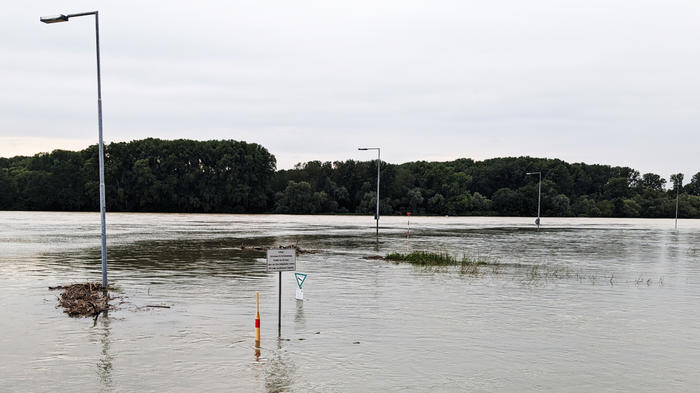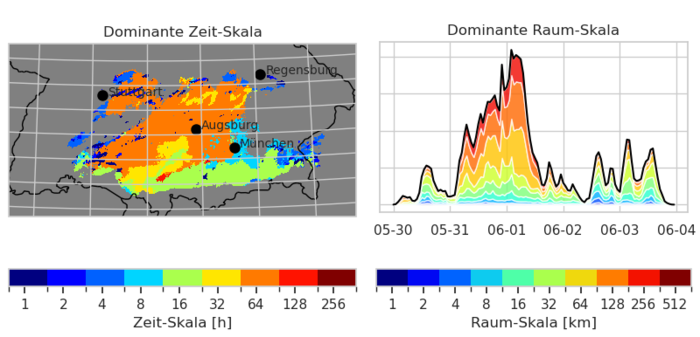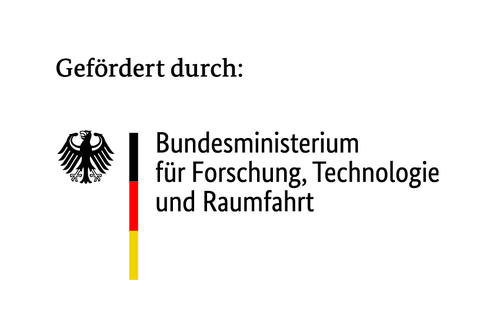Hochwasserlage Mai/Juni 2024
Vom 30. Mai bis zum 06. Juni 2024 führten langanhaltende Niederschläge über Süddeutschland zu schwerwiegenden Überschwemmungen.
11.06.2024
Hochwasser am Rhein (bei Karlsruhe), 02.06.24.
Bildquelle: Quelle: Susanna Mohr /KIT
Vorherrschende zeitliche und räumliche Skala des Niederschlags.
Bildquelle: Friederichs et al. (2024)
Ereignisse dieser Art sind ein Forschungsschwerpunkt des vom BMBF geförderten Projektes ClimXtreme. ClimXtreme hat zum Ziel, eine Wissensbasis zu erstellen, die Entscheidungen zu Maßnahmen zur Verhinderung schwerer Schäden durch extreme Wetterereignisse unterstützen kann. Die Forschung zielt auf ein besseres Verständnis der physikalischen Prozesse ab, die ein extremes Wetterereignis zu einer großen Gefahr machen. Eine wichtige Frage ist, ob und wie stark aktuelle Extremereignisse durch den menschengemachten Klimawandel beeinflusst sind, und wie sich diese in einem zukünftigen Klima verhalten werden.
Wir ordnen in diesem Bericht das aktuelle Hochwasserereignis mit den in ClimXtreme entwickelten Methoden ein. Die hier dargestellten Ergebnisse spiegeln daher den aktuellen Stand der laufenden Forschung wider. Im Vergleich der verschiedenen wissenschaftlichen Ansätze wird deutlich, dass die Einordnung des Ereignisses in Bezug auf frühere Extrema vom gewählten Blickwinkel abhängt, und damit auf den ersten Blick ein scheinbar uneinheitliches Bild ergibt.
Zusammenfassung
Die ergiebigen Niederschläge von teilweise mehr als 250 mm innerhalb von sechs Tagen fielen während einer stationären großräumigen Wetterlage über Europa. Das Starkregenereignis setzte sich aus Niederschlagsmustern auf verschiedenen Raum- und Zeitskalen zusammen (siehe Abbildung oben, Beschreibung siehe Abb. 6 in Abschnitt 1.3.2) und war zusätzlich geprägt durch starke konvektive Anteile im Niederschlag. Bemerkenswert ist die lange Dauer des räumlich stark ausgedehnten Niederschlagsgebiets. In Bezug auf Niederschlag stellt das Ereignis nur lokal ein Jahrhundertereignis dar. Ähnliche oder stärkere Ereignisse bezüglich Ausdehnung, Niederschlagsdauer und Menge wurden in der Vergangenheit bereits mehrfach beobachtet.
Trotzdem weist das Hochwasser 2024 die zweitgrößte Abflussrekordanomalie in der Region seit 100 Jahren nach 2013 auf. Entsprechend ist auch die simulierte Abflussreaktion außergewöhnlich und impliziert teils Wiederkehrzeiten von deutlich über 100 Jahren.
Auf Basis von Stationsdaten in Süddeutschland lassen sich keine einheitlichen Veränderungen in der Statistik extremer Niederschlagsereignisse detektieren, die dem Klimawandel zugeordnet werden können. Die probabilistische Attributionsstudie ordnet dem aktuellen Ereignis eine 30-jährige Wiederkehrzeit zu, wobei die Wahrscheinlichkeit dieses Ereignisses sich im Vergleich zu einem vorindustriellen Klima um einen Faktor 1,4 (Unsicherheit: 0,8 bis 4,4) erhöht hat und eine weitere Zunahme in einem wärmeren Klima erwartet wird.
Für das spezifische Ereignis ergeben regionale Simulationen, dass es in einem präindustriellen Klima weniger intensiv gewesen wäre. Die höhere Gesamtintensität des Ereignisses im jetzigen Klima beruht vor allem auf einer Zunahme kleinskaliger Niederschläge mit moderater Intensität. Hochauflösende Klimasimulationen zeigen hinsichtlich der raumzeitlichen Ausprägung von Starkregenereignissen im Mittel aber keine signifikanten Änderungen zwischen Vergangenheit, Gegenwart und Zukunft.
Um den vollständigen Bericht aufzurufen, klicken Sie bitte auf den folgenden Link.




